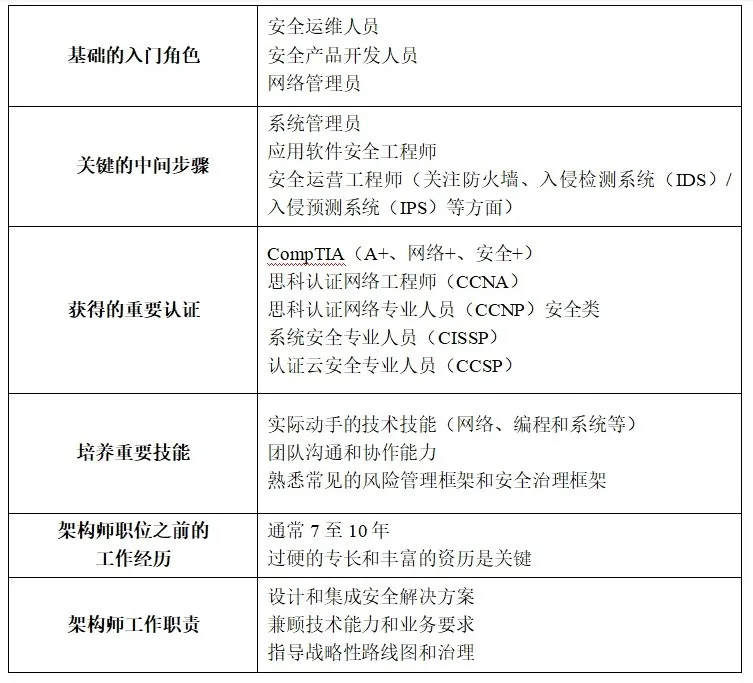How to become a network security architect?

Cybersecurity architects are responsible for designing and implementing a comprehensive, real-time cybersecurity framework to protect an organization's digital assets. Their work is significant, ensuring that organizations have a strong security posture while developing digital transformation. Lester Nichols, Vice President of Cybersecurity Operations and Director of Security Architecture at JPMorgan Chase, believes that cybersecurity architects will become a critical position needed by all modern enterprises. But this is not an easy job, and it requires years of technical preparation and security operations experience.

For professionals who aspire to become network security architects, reading the "Network Security Architect's Handbook" written by Nichols will fully understand the complexity of the network security architect role and how to be competent in this role. Nichols recommends in the book that before becoming an architect, you first need to hone your skills in early positions such as network operations or security administrators and master the basic skills and knowledge in the following areas:
- Understand the network. Many network attacks occur on devices connected to the network, so analysts need to understand wired and wireless networks and develop targeted protection plans;
- Understand operating systems. Almost all operating systems have security risks. If you are very familiar with MacOS, Windows, and Linux and their command line interfaces, it will be very helpful for you to be competent as a network security architect.
- Understand programming. The work of a network security architect does not require a lot of coding, but having a basic understanding of programming languages such as JavaScript, Python, and C/C++ will enable you to better understand the execution flow of attack tasks and how to expand the functionality of the system.
The above aspects cover "80% to 90% of the dirty and hard work" in cybersecurity work, but other high-level cybersecurity work is built on them.
Growing from a junior cybersecurity position to a senior cybersecurity architect requires going through many difficult steps. This article excerpts part of Chapter 7 of the Cybersecurity Architect Growth Handbook, providing a development roadmap for becoming a cybersecurity architect, including steps to achieve your goals, a learning plan, and training recommendations.

Table 1: Growth path to becoming a network security architect
For security professionals just entering the technical workforce, early roles often focus on building core competencies such as networking, system administration, and basic programming. At this stage, it is important to avoid specializing too early and explore a wide range of areas surrounding cybersecurity. Continuously learning new technologies and skills, trying side projects that are unexpected for cybersecurity, and avoiding complacency are key to success at this stage. Certifications such as A+, Network+, and language-specific programming certificates can help bolster new entrants’ industry credibility.
Obtaining key certifications early can demonstrate core competencies. Study guides, practice tests, and online courses can prepare for exams such as CompTIA A+, Network+, and Security+. It is recommended to schedule 10 to 15 hours of study per week in the first two years and actually pass 3 to 4 basic competency certifications. Studying peripheral areas can develop all-round capabilities.
Going from an entry-level technical role to a network security architect requires careful planning, broadening your skills, and keeping up with industry trends. While this journey may start in different technical areas, it ultimately leads to a comprehensive understanding of network security principles. Here are a few in-depth examples of pathways and tailored learning and training plans to progress from an entry-level technical role to a network security architect:
Mode 1: Start from the security support position of Party A
If you are starting your cybersecurity career in a help desk support position, you should first work towards a system administrator role to gain network and system expertise. Earn cybersecurity certifications such as Security+, CISSP, and Certified Ethical Hacker (CEH) in your spare time. After 3 to 5 years, you can try to switch to an information security analyst job and obtain professional certifications such as CCSP in the process, which will give you the opportunity to lead specific security engineering projects. After 7 to 10 years of working as a security analyst, you will be qualified and capable of becoming a cybersecurity architect.
Self-study plan:
- 1 to 2 years: Focus on learning basic IT concepts and obtaining certificates such as A+ to avoid over-specialization too early.
- Year 3 to 4: Dive deeper into networking knowledge through certifications such as Network+ and begin exploring cybersecurity concepts. Prepare for and obtain Security+ certification.
- 5 to 6 years: Spend a lot of time studying advanced cybersecurity knowledge. Strive to obtain CISSP and CEH certifications.
Job Training:
- Participate in hands-on labs and real-world scenarios.
- Join online forums and communities focused on systems administration and network security.
- Attend seminars and conferences.
Pitfalls to watch out for:
- Limited to non-technical support roles.
- Not getting enough practical safety experience early on.
Mode 2: Starting from Party A’s network management work
For those who work in the network management position of the client, they should obtain vendor certificates such as CCNA as early as possible, acquire firewall configuration skills, and participate in as many security activities and policy planning as possible. After working for 2 to 3 years, you can apply to switch to the role of security operations engineer. At this stage, you should continue to study and obtain advanced certificates such as CCNP Security and CISSP, and look for opportunities to gain experience in cloud and identity management systems. After more than 6 years of practical skills, you will be initially qualified for the position of network security architect.
Self-study plan:
- 1 to 2 years: Obtain basic network certification such as CCNA, and learn the configuration and security protocols of common security products such as firewalls.
- 3 to 4 years: Deepen your cybersecurity knowledge. Obtain certifications such as CCNP Security and deepen your understanding of cloud security principles.
- 5 to 6 years: Focus on comprehensive cybersecurity principles and work toward obtaining the CISSP certification.
Job Training:
- Take a specialized cybersecurity training course.
- Actively strive to participate in simulated network attack and defense exercises.
- Attend industry conferences focused on cybersecurity trends and innovations.
Pitfalls to watch out for:
- Long limited to pure network operations roles.
- Does not extend to comprehensive security architecture and policy development.
Mode 3: Start with software programming work at a security vendor
If you start out as a software programmer for a security vendor, you need to learn and accumulate experience in secure programming practices and designing secure architectures on the job. You can learn the basics of system administration outside of work. After a few years, strive to upgrade to the role of an application software security engineer and obtain advanced certificates such as CompTIA Advanced Security Practitioner (CASP+), as well as expertise in auditing and penetration testing. After more than 5 years, you can aim to become a chief architect focused on application software and application programming interface (API) security.
During this process, you need to develop a training plan that focuses on learning for the next career stage: Those aiming to become security analysts can study for intermediate certificates, such as Security+ and CISSP, while working. Studying 1 to 2 hours on weekday evenings and 4 to 6 hours on weekends can fully prepare for the certification exams in 6 to 12 months.
Self-study plan:
- 1-2 years: Start learning cybersecurity fundamentals while mastering programming. Pursue a certification focused on secure programming practices.
- 3-4 years: Shift focus to designing security architecture and delve deeper into system administration fundamentals. Obtain CASP+ certification.
- 5 to 6 years: Deepen your expertise in application security and earn advanced certifications such as CISSP.
Job Training:
- Take a security-focused coding bootcamp.
- Participate in security coding challenges and capture the flag events.
- Regularly attend workshops and seminars on secure application software design and development.
Pitfalls to watch out for:
- No broad base has been gained in networking or infrastructure.
- Allowing programming skills to become obsolete.
Conclusion
Regardless of your technical starting point in the cybersecurity field, becoming a qualified cybersecurity architect requires a multi-pronged learning approach. In this process, it is particularly important to emphasize continuous learning, acquire rich technical skills, and ensure practical experience. If you follow a scientific growth path and avoid common development pitfalls at work, professionals are more likely to obtain senior cybersecurity roles and ensure that they are fully prepared when facing the challenges and responsibilities of architect positions. The key to becoming a cybersecurity architect is to balance the study of professional certificates, hands-on experiments, relevant knowledge, and forward-looking new technologies, use the resources of your organization to master the basics as much as possible, and avoid low-level traps.
Reference link: https://www.techtarget.com/searchsecurity/feature/How-to-become-a-cybersecurity-architect